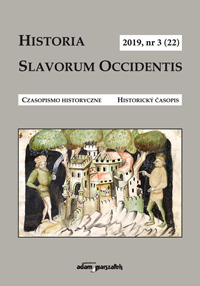Gospodarka, polityka a tożsamości: Galicja i Monarchia Habsburska w długim XIX wieku na tle debaty historiograficznej o imperium, narodzie i regionie
Economy, politics and identity: Galicia and the Habsburg Monarchy in the 19th century in the light of a historiographical debate on the empire, nation and region
Author(s): Klemens KapsSubject(s): History, Political history
Published by: Wydawnictwo Adam Marszałek
Keywords: Galicia; Habsburg Monarchy; economic development; transregional division of labour; national identities; Empire history
Summary/Abstract: Recently, history as a discipline of science has experienced a spatial turn; global history has corroborated the focus on intertwined regions, states and empires in terms of economic, social and cultural interactions. By applying new approaches to empires, this article reconsiders the economic development of Habsburgs’ Galicia between the annexation and separation of this region in the First Partition of the Polish-Lithuanian Commonwealth until the end of WWI and the fall of the Habsburg Empire. The major argument put forward in this article is that economic growth was heavily influenced by both the political institutions and the cultural identities in Galicia which transformed into national identities in the course of the eventful 19th century. Three development phases have been identified, corresponding with different economic paradigms, namely cameralism, liberalism and organized capitalism. They have been superimposed onto the social structure, the changing institutional framework of the Habsburg Empire ranging from efforts at centralization in the late 18th century to democratization and federalization concessions in the 1860s, coupled with the formation of group identities in regions, cultures and nations. Trade and industry-related policies often hampered Galicia’s economic growth giving preference to the economic core areas in Bohemia and Austria at the expense of the newly acquired province on the outskirts of the Empire. Many other areas acquired a much more ambivalent status. This holds true for the fiscal policy where the net tax in Galicia equalled the average tax, and for many public investments, in particular after 1867, improved infrastructure and education. On the other hand, the agrarian reforms improving the legal position of tenants against their lords is another example of the positive effects of the Habsburg rule on Galicia’s economy. However, all of the measures differently affected the region’s population according to the social position and economic and political interests. Oftentimes, it is impossible to clearly separate the benefits for the region and for the empire, e.g. when the construction of railways stimulated regional exports as well as imports, pushing the regional producers from the market. Another example are military investments which improved national security but were strictly related to the Empire’s geopolitical position to which the region had to contribute by being a part of a pact (questionable from a national perspective) and the main theatre of war. The evolving national identities posed an increasing threat of adding an ethnic aspect to the economy. However, there were important factors, predominantly social ones, that kept in check the demarcation lines and contributed to maintaining a high level of intercultural cooperation. In fact, while Galicia’s peripheral economic position in the Habsburg Empire strongly provoked inter-ethnic conflicts and struggle for limited resources, it was an imperial framework conducive for forging national identities.
Journal: Historia Slavorum Occidentis
- Issue Year: 22/2019
- Issue No: 3
- Page Range: 127-156
- Page Count: 30
- Language: Polish

